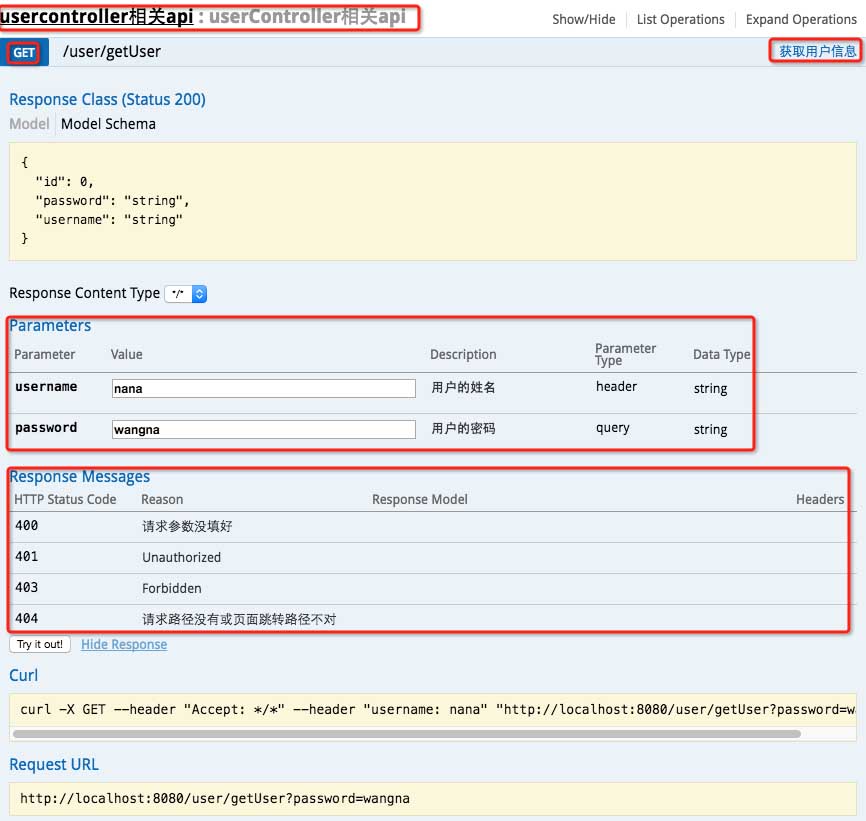жӮЁеҘҪпјҢзҷ»еҪ•еҗҺжүҚиғҪдёӢи®ўеҚ•е“ҰпјҒ
иҝҷзҜҮж–Үз« дё»иҰҒи®Іи§ЈдәҶвҖңеҰӮдҪ•дҪҝз”Ё@ApiImplicitParamsгҖҒApiImplicitParamвҖқпјҢж–Үдёӯзҡ„и®Іи§ЈеҶ…е®№з®ҖеҚ•жё…жҷ°пјҢжҳ“дәҺеӯҰд№ дёҺзҗҶи§ЈпјҢдёӢйқўиҜ·еӨ§е®¶и·ҹзқҖе°Ҹзј–зҡ„жҖқи·Ҝж…ўж…ўж·ұе…ҘпјҢдёҖиө·жқҘз ”з©¶е’ҢеӯҰд№ вҖңеҰӮдҪ•дҪҝз”Ё@ApiImplicitParamsгҖҒApiImplicitParamвҖқеҗ§пјҒ
@ApiImplicitParam
еҸӮж•°
зұ»еһӢ дҪңз”Ё
@ApiImplicitParams
paramType зӨәдҫӢиҜҰи§Ј
е°Ҹз»“дёҖдёӢ
жөӢиҜ•
дҪңз”ЁеңЁж–№жі•дёҠпјҢиЎЁзӨәеҚ•зӢ¬зҡ„иҜ·жұӮеҸӮж•°
nameпјҡеҸӮж•°еҗҚгҖӮ
valueпјҡеҸӮж•°зҡ„е…·дҪ“ж„Ҹд№үпјҢдҪңз”ЁгҖӮ
requiredпјҡеҸӮж•°жҳҜеҗҰеҝ…еЎ«гҖӮ
dataTypeпјҡеҸӮж•°зҡ„ж•°жҚ®зұ»еһӢгҖӮ
paramTypeпјҡжҹҘиҜўеҸӮж•°зұ»еһӢпјҢиҝҷйҮҢжңүеҮ з§ҚеҪўејҸпјҡ
path д»Ҙең°еқҖзҡ„еҪўејҸжҸҗдәӨж•°жҚ®
query зӣҙжҺҘи·ҹеҸӮж•°е®ҢжҲҗиҮӘеҠЁжҳ е°„иөӢеҖј
body д»ҘжөҒзҡ„еҪўејҸжҸҗдәӨ д»…ж”ҜжҢҒPOST
header еҸӮж•°еңЁrequest headers йҮҢиҫ№жҸҗдәӨ
form д»ҘformиЎЁеҚ•зҡ„еҪўејҸжҸҗдәӨ д»…ж”ҜжҢҒPOST
еңЁиҝҷйҮҢжҲ‘иў«еқ‘иҝҮдёҖж¬ЎпјҡеҪ“жҲ‘еҸ‘POSTиҜ·жұӮзҡ„ж—¶еҖҷпјҢеҪ“ж—¶жҺҘеҸ—зҡ„ж•ҙдёӘеҸӮж•°пјҢдёҚи®әжҲ‘з”ЁbodyиҝҳжҳҜqueryпјҢеҗҺеҸ°йғҪдјҡжҠҘBody Missingй”ҷиҜҜгҖӮ
иҝҷдёӘеҸӮж•°е’ҢSpringMvcдёӯзҡ„@RequestBodyеҶІзӘҒпјҢзҙўжҖ§жҲ‘е°ұеҺ»жҺүдәҶparamTypeпјҢеҜ№жҺҘеҸЈжөӢиҜ•е№¶жІЎжңүеҪұе“ҚгҖӮ
з”ЁдәҺж–№жі•пјҢеҢ…еҗ«еӨҡдёӘ @ApiImplicitParamпјҡ
дҫӢпјҡ
@ApiOperation("жҹҘиҜўжөӢиҜ•")
@GetMapping("select")
//@ApiImplicitParam(name="name",value="з”ЁжҲ·еҗҚ",dataType="String", paramType = "query")
@ApiImplicitParams({
@ApiImplicitParam(name="name",value="з”ЁжҲ·еҗҚ",dataType="string", paramType = "query",example="xingguo"),
@ApiImplicitParam(name="id",value="з”ЁжҲ·id",dataType="long", paramType = "query")})
public void select(){
}path
@RequestMapping(value = "/findById1/{id}", method = RequestMethod.GET, produces = MediaType.APPLICATION_JSON_UTF8_VALUE)
@PathVariable(name = "id") Long idbody
@ApiImplicitParams({ @ApiImplicitParam(paramType = "body", dataType = "MessageParam", name = "param", value = "дҝЎжҒҜеҸӮж•°", required = true) })
@RequestMapping(value = "/findById3", method = RequestMethod.POST, produces = MediaType.APPLICATION_JSON_UTF8_VALUE, consumes = MediaType.APPLICATION_JSON_VALUE)
@RequestBody MessageParam paramжҸҗдәӨзҡ„еҸӮж•°жҳҜиҝҷдёӘеҜ№иұЎзҡ„дёҖдёӘjsonпјҢ然еҗҺдјҡиҮӘеҠЁи§ЈжһҗеҲ°еҜ№еә”зҡ„еӯ—ж®өдёҠеҺ»пјҢд№ҹеҸҜд»ҘйҖҡиҝҮжөҒзҡ„еҪўејҸжҺҘ收еҪ“еүҚзҡ„иҜ·жұӮж•°жҚ®пјҢдҪҶжҳҜиҝҷдёӘе’ҢдёҠйқўзҡ„жҺҘ收方ејҸд»…иғҪдҪҝз”ЁдёҖдёӘпјҲз”Ё@RequestBodyд№ӢеҗҺжөҒе°ұдјҡе…ій—ӯдәҶпјү
header
@ApiImplicitParams({ @ApiImplicitParam(paramType = "header", dataType = "Long", name = "id", value = "дҝЎжҒҜid", required = true) })
String idstr = request.getHeader("id");
if (StringUtils.isNumeric(idstr)) {
id = Long.parseLong(idstr);
}Form
@ApiImplicitParams({ @ApiImplicitParam(paramType = "form", dataType = "Long", name = "id", value = "дҝЎжҒҜid", required = true) })
@RequestMapping(value = "/findById5", method = RequestMethod.POST, produces = MediaType.APPLICATION_JSON_UTF8_VALUE, consumes = MediaType.APPLICATION_FORM_URLENCODED_VALUE)(1)еҜ№дәҺ@ApiImplicitParamзҡ„paramTypeпјҡqueryгҖҒformеҹҹдёӯзҡ„еҖјйңҖиҰҒдҪҝз”Ё@RequestParamиҺ·еҸ–пјҢ headerеҹҹдёӯзҡ„еҖјйңҖиҰҒдҪҝз”Ё@RequestHeaderжқҘиҺ·еҸ–пјҢpathеҹҹдёӯзҡ„еҖјйңҖиҰҒдҪҝз”Ё@PathVariableжқҘиҺ·еҸ–пјҢbodyеҹҹдёӯзҡ„еҖјдҪҝз”Ё@RequestBodyжқҘиҺ·еҸ–пјҢеҗҰеҲҷеҸҜиғҪеҮәй”ҷпјӣиҖҢдё”еҰӮжһңparamTypeжҳҜbodyпјҢnameе°ұдёҚиғҪжҳҜbodyпјҢеҗҰеҲҷжңүй—®йўҳпјҢдёҺе®ҳж–№ж–ҮжЎЈдёӯзҡ„вҖңIf paramType is "body", the name should be "body"дёҚз¬ҰгҖӮ
@ApiImplicitParamsпјҡз”ЁеңЁж–№жі•дёҠеҢ…еҗ«дёҖз»„еҸӮж•°иҜҙжҳҺ
@ApiImplicitParamпјҡз”ЁеңЁ@ApiImplicitParamsжіЁи§ЈдёӯпјҢжҢҮе®ҡдёҖдёӘиҜ·жұӮеҸӮж•°зҡ„еҗ„дёӘж–№йқў
paramTypeпјҡеҸӮж•°ж”ҫеңЁе“ӘдёӘең°ж–№
header-->иҜ·жұӮеҸӮж•°зҡ„иҺ·еҸ–пјҡ@RequestHeader
query-->иҜ·жұӮеҸӮж•°зҡ„иҺ·еҸ–пјҡ@RequestParam
pathпјҲз”ЁдәҺrestfulжҺҘеҸЈпјү-->иҜ·жұӮеҸӮж•°зҡ„иҺ·еҸ–пјҡ@PathVariable
bodyпјҲдёҚеёёз”Ёпјү
formпјҲдёҚеёёз”Ёпјү
nameпјҡеҸӮж•°еҗҚ
dataTypeпјҡеҸӮж•°зұ»еһӢ
requiredпјҡеҸӮж•°жҳҜеҗҰеҝ…йЎ»дј
valueпјҡеҸӮж•°зҡ„ж„ҸжҖқ
defaultValueпјҡеҸӮж•°зҡ„й»ҳи®ӨеҖј
@ApiResponsesпјҡз”ЁдәҺиЎЁзӨәдёҖз»„е“Қеә”
@ApiResponseпјҡз”ЁеңЁ@ApiResponsesдёӯпјҢдёҖиҲ¬з”ЁдәҺиЎЁиҫҫдёҖдёӘй”ҷиҜҜзҡ„е“Қеә”дҝЎжҒҜ
codeпјҡж•°еӯ—пјҢдҫӢеҰӮ400
messageпјҡдҝЎжҒҜпјҢдҫӢеҰӮ"иҜ·жұӮеҸӮж•°жІЎеЎ«еҘҪ"
responseпјҡжҠӣеҮәејӮеёёзҡ„зұ»
д»ҘдёҠиҝҷдәӣе°ұжҳҜжңҖеёёз”Ёзҡ„еҮ дёӘжіЁи§ЈдәҶгҖӮ
import org.springframework.beans.factory.annotation.Autowired;
import org.springframework.web.bind.annotation.RequestHeader;
import org.springframework.web.bind.annotation.RequestMapping;
import org.springframework.web.bind.annotation.RequestMethod;
import org.springframework.web.bind.annotation.RequestParam;
import org.springframework.web.bind.annotation.RestController;
import io.swagger.annotations.Api;
import io.swagger.annotations.ApiImplicitParam;
import io.swagger.annotations.ApiImplicitParams;
import io.swagger.annotations.ApiOperation;
import io.swagger.annotations.ApiResponse;
import io.swagger.annotations.ApiResponses;
@RestController
@RequestMapping("/user")
@Api("userControllerзӣёе…іapi")
public class UserController {
@Autowired
private UserService userService;
@ApiOperation("иҺ·еҸ–з”ЁжҲ·дҝЎжҒҜ")
@ApiImplicitParams({
@ApiImplicitParam(paramType="header",name="username",dataType="String",required=true,value="з”ЁжҲ·зҡ„姓еҗҚ",defaultValue="zhaojigang"),
@ApiImplicitParam(paramType="query",name="password",dataType="String",required=true,value="з”ЁжҲ·зҡ„еҜҶз Ғ",defaultValue="wangna")
})
@ApiResponses({
@ApiResponse(code=400,message="иҜ·жұӮеҸӮж•°жІЎеЎ«еҘҪ"),
@ApiResponse(code=404,message="иҜ·жұӮи·Ҝеҫ„жІЎжңүжҲ–йЎөйқўи·іиҪ¬и·Ҝеҫ„дёҚеҜ№")
})
@RequestMapping(value="/getUser",method=RequestMethod.GET)
public User getUser(@RequestHeader("username") String username, @RequestParam("password") String password) {
return userService.getUser(username,password);
}
}еҗҜеҠЁжңҚеҠЎпјҢжөҸи§ҲеҷЁиҫ“е…Ҙ"http://localhost:8080/swagger-ui.html"

еңЁдёҠйқўжЎҲдҫӢдёӯжҲ‘们еҸҜд»ҘзҹҘйҒ“еҰӮжһңеңЁrequestеҹҹдёӯжҲ‘们дҪҝз”Ёreques.getHeader()е’ҢдҪҝз”Ё@RequestHeaderжіЁи§ЈдҪңз”ЁжҳҜдёҖж ·зҡ„пјҢе…¶е®ғеҶ…е®№зұ»дјјгҖӮ
@ApiResponsesпјҡз”ЁдәҺиЎЁзӨәдёҖз»„е“Қеә”
@ApiResponseпјҡз”ЁеңЁ@ApiResponsesдёӯпјҢдёҖиҲ¬з”ЁдәҺиЎЁиҫҫдёҖдёӘй”ҷиҜҜзҡ„е“Қеә”дҝЎжҒҜ
codeпјҡж•°еӯ—пјҢдҫӢеҰӮ400
messageпјҡдҝЎжҒҜпјҢдҫӢеҰӮвҖқиҜ·жұӮеҸӮж•°жІЎеЎ«еҘҪвҖқ
responseпјҡжҠӣеҮәејӮеёёзҡ„зұ»
@ApiOperation("иҺ·еҸ–з”ЁжҲ·дҝЎжҒҜ")
@ApiImplicitParams({@ApiImplicitParam(paramType="header",name="name",dataType="String",required=true,value="з”ЁжҲ·зҡ„姓еҗҚ",defaultValue="zhaojigang"),
@ApiImplicitParam(paramType="query",name="pwd",dataType="String",required=true,value="з”ЁжҲ·зҡ„еҜҶз Ғ",defaultValue="wangna")
})
@ApiResponses({ @ApiResponse(code=400,message="иҜ·жұӮеҸӮж•°жІЎеЎ«еҘҪ"),
@ApiResponse(code=404,message="иҜ·жұӮи·Ҝеҫ„жІЎжңүжҲ–йЎөйқўи·іиҪ¬и·Ҝеҫ„дёҚеҜ№")
})
@RequestMapping(value="/getUser",method= RequestMethod.GET)
public User getUser(@RequestHeader("name") String name,@RequestParam("pwd") String pwd) {
System.out.println(name);
System.out.println(pwd);
return userRepository.getUserByNameAndPwd(name,pwd);
}ж„ҹи°ўеҗ„дҪҚзҡ„йҳ…иҜ»пјҢд»ҘдёҠе°ұжҳҜвҖңеҰӮдҪ•дҪҝз”Ё@ApiImplicitParamsгҖҒApiImplicitParamвҖқзҡ„еҶ…е®№дәҶпјҢз»ҸиҝҮжң¬ж–Үзҡ„еӯҰд№ еҗҺпјҢзӣёдҝЎеӨ§е®¶еҜ№еҰӮдҪ•дҪҝз”Ё@ApiImplicitParamsгҖҒApiImplicitParamиҝҷдёҖй—®йўҳжңүдәҶжӣҙж·ұеҲ»зҡ„дҪ“дјҡпјҢе…·дҪ“дҪҝз”Ёжғ…еҶөиҝҳйңҖиҰҒеӨ§е®¶е®һи·өйӘҢиҜҒгҖӮиҝҷйҮҢжҳҜдәҝйҖҹдә‘пјҢе°Ҹзј–е°ҶдёәеӨ§е®¶жҺЁйҖҒжӣҙеӨҡзӣёе…ізҹҘиҜҶзӮ№зҡ„ж–Үз« пјҢж¬ўиҝҺе…іжіЁпјҒ
е…ҚиҙЈеЈ°жҳҺпјҡжң¬з«ҷеҸ‘еёғзҡ„еҶ…е®№пјҲеӣҫзүҮгҖҒи§Ҷйў‘е’Ңж–Үеӯ—пјүд»ҘеҺҹеҲӣгҖҒиҪ¬иҪҪе’ҢеҲҶдә«дёәдё»пјҢж–Үз« и§ӮзӮ№дёҚд»ЈиЎЁжң¬зҪ‘з«ҷз«ӢеңәпјҢеҰӮжһңж¶үеҸҠдҫөжқғиҜ·иҒ”зі»з«ҷй•ҝйӮ®з®ұпјҡis@yisu.comиҝӣиЎҢдёҫжҠҘпјҢ并жҸҗдҫӣзӣёе…іиҜҒжҚ®пјҢдёҖз»ҸжҹҘе®һпјҢе°Ҷз«ӢеҲ»еҲ йҷӨж¶үе«ҢдҫөжқғеҶ…е®№гҖӮ
жӮЁеҘҪпјҢзҷ»еҪ•еҗҺжүҚиғҪдёӢи®ўеҚ•е“ҰпјҒ